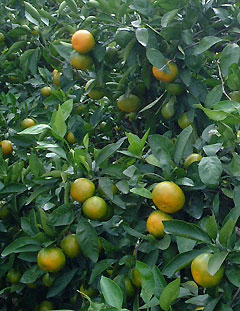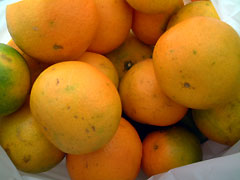 Today we went mikan hunting.
Today we went mikan hunting.
I’d seen a sign for mikangari when we were driving around Oita and it struck me a fun activity. The Seto area is known for its mikan farms, so upon arriving in Onomichi yesterday, we went to the tourist information center to ask. They gave us a map and some phone numbers for the mikan farms on Mukaishima, the island across the harbour.
This morning after breakfast, Tod called around to find one that was open, and we took the ferry over. It was a longish walk out of town to the mikan farm and we might have been the only people on the island who were walking. Everyone else had a car or a bicycle, but I was not going to spoil my holiday by riding a bike.
An older couple was sitting in a shed, weighing, trimming and taping bundles of aonegi, green onions. They were prepared for our arrival, but I don’t think that a lot of Westerners arrive on foot at their farm to pick oranges. But we did and they were gracious. The woman handed us short, curved blade scissors and a plastic bag as the man explained that he’d take us up to the grove.
“It’s 500 yen for all-you-can-eat, and 600 yen if you want to take them home in the bag.” he told us. Then he straddled his bicycled and rode slowly up the lane, asking a million questions to Tod. The mikan grove was at the top of a hill overlooking the sea. It was fabulous.
 After a quick lesson on how to select and cut the mikan, we were on our own. We spent a very happy half hour crawling under the diminutive trees hunting for the tastiest mikan. As they ripen, dark green gives way to brighter green and yellows, then becomes progressively redder until reaching a brilliant orange. Fortunately for us, partially ripe mikan are also delicious, if not quite as sweet, and we gathered a half a bag to carry back with us.
After a quick lesson on how to select and cut the mikan, we were on our own. We spent a very happy half hour crawling under the diminutive trees hunting for the tastiest mikan. As they ripen, dark green gives way to brighter green and yellows, then becomes progressively redder until reaching a brilliant orange. Fortunately for us, partially ripe mikan are also delicious, if not quite as sweet, and we gathered a half a bag to carry back with us.
Instead of walking straight back to the ferry, we opted to make a loop around part of the island. It turned out to be a long dull walk, but enjoyable for the exercise and the chance to breathe fresh air. Tod kept hoping for a bus, but they only run four times a day, and there wasn’t one when we needed it.
By late afternoon we were back in Onomichi, and visited the Motion Picture Museum, which features the films made locally. All of the tourist maps have the key roke, filming locations, marked on them but they are all for films we’ve never seen—old Japanese dramas and period pieces. The museum wasn’t much, but it had photos from all the films and a display of old cameras and projectors. The museum’s own theater (ironically, the only theatre in Onomichi) screened some clever short films made in a local contest, and a history of film in Onomichi. Made me wish I’d brought my video camera.
Posted by kuri at October 15, 2003 11:59 PMDo Mikan’s make yummy mikan-shu? I make my own ume-shu, but this year I want make something a bit different…
Posted by: Tracey on October 20, 2003 04:07 PM